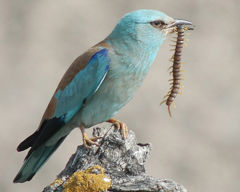- Coraciiformes
-
Coraciiformes 
European Roller
Coracias garrulusScientific classification Kingdom: Animalia Phylum: Chordata Class: Aves Infraclass: Neognathae Order: Coraciiformes
Forbes, 1884Families Alcedinidae
Brachypteraciidae
Bucerotidae (disputed)
Cerylidae
Coraciidae
Halcyonidae
Meropidae
Momotidae
Phoeniculidae (disputed)
Todidae
Upupidae (disputed)
For prehistoric taxa, see text.
Global distribution of the Kingfisher and allies. The Coraciiformes are a group of usually colorful near passerine birds including the kingfishers, the Hoopoe, the bee-eaters, the rollers, and the hornbills. They generally have syndactyly, with three forward-pointing toes (and toes 3 & 4 fused at their base), though in many kingfishers one of these is missing.
This is largely an Old World order, with the representation in the New World limited to the dozen or so species of todies and motmots, and a mere handful of the more than 90 species of kingfishers. This is the most diverse bird order in body weight, ranging from the 5.5 gram Puerto Rican Tody (Todus mexicanus) to the 4.5 kg Southern Ground Hornbill (Bucorvus leadbeateri), if the hornbills indeed belong under this classification.
The name Coraciiformes means "Raven-like", which is a misnomer (ravens are passerines). Specifically, it comes from the Latin language "Corax", meaning "Raven" and Latin "Forma", meaning "form", which is the standard ending for bird orders. [Terres p 104]
Contents
Systematics
This order has been seen to be something of a mixed assortment, and the Coraciiformes may be considered as including only the rollers. All the other families would then be considered to represent lineages of birds distantly related to Coraciiformes. This seems to be oversplitting, as most Coraciiformes indeed form a reasonably robust clade.
Analysis of nDNA c-myc and RAG-1 exon as well as mtDNA myoglobin intron 2 sequence data demonstrates that the Coraciiformes can be divided into a basal group that is not too distantly related to the Piciformes, and a derived suborder containing mainly kingfishers (Johansson & Ericson, 2003). The Cuckoo-roller's true affinities appear to lie elsewhere[citation needed]. The trogons and hornbills are either very basal lineages, or might be considered distinct own orders; the latter are apparently slightly closer to the rollers than the former. The entire group (possibly excluding the Cuckoo-roller) and the Piciformes are closely related to the Passeriformes (Johansson & Ericson 2003; see also Near passerine).
Several extinct coraciiform families are only known from Paleogene fossils. They probably belong to the basal group and are sometimes difficult to assign because they were even closer still to the Piciformes (see also Neanis). In addition, there are some prehistoric genera which are likewise difficult to place into a family. At least the Eocoraciidae are very basal, but the Late Eocene (some 35 mya) Geranopteridae form a superfamily Coracioidea with the extant rollers and ground-rollers already (Mayr & Mourer-Chauviré 2000). A few prehistoric taxa of the present-day families have been described; see the family articles for details.
Taxonomic sequence
Unresolved
- Genus Quasisyndactylus (fossil; Middle Eocene of Messel, Germany) - alcediniform, basal?
- Genus Cryptornis (fossil; Late Eocene of France) – bucerotid? geranopterid?
- Family Primobucconidae (fossil)
- Coraciiformes gen. et spp. indet. PQ 1216, QU 15640 (fossil; Late Eocene of Quercy, France: Mayr & Mourer-Chauviré 2000)
- Genus Protornis (fossil: Oligocene of Switzerland) – basal to motmotids and meropids?
A recent study suggest that the following families may belong to a separate order called Bucerotiformes. The results still in dispute though.[1]
- Family Bucerotidae (Hornbills)
- Family Upupidae (Hoopoe)
- Family Phoeniculidae (Woodhoopoes)
The Leptosomatidae (Cuckoo-roller) probably do not belong here. The trogons are sometimes placed here as a family Trogonidae. The Late Eocene Palaeospizidae are sometimes also placed in the Coraciiformes, as are the Early to Middle Eocene Primobucconidae and the Middle Eocene to Early Oligocene Sylphornithidae. The Primobucconidae at least indeed seem to belong here.
Basal group
- Family Eocoraciidae (fossil; Middle Eocene of Messel, Germany)
- Family Messelirrisoridae (fossil; Middle Eocene)
- Family Geranopteridae (fossil; Late Eocene of Quercy, France - Early Miocene of Czechia) - includes "Nupharanassa" bohemica
- Family Coraciidae (rollers)
- Family Brachypteraciidae (ground-rollers)
- Family Meropidae (bee-eaters)
Suborder Alcedini
- Family Todidae (todies)
- Family Momotidae (motmots)
- Family Alcedinidae (river-kingfishers)
- Family Halcyonidae (tree-kingfishers)
- Family Cerylidae (water- or belted kingfishers)
References
- Johansson, Ulf S. & Ericson, Per G. P. (2003): Molecular support for a sister group relationship between Pici and Galbulae (Piciformes sensu Wetmore 1960). J. Avian Biol. 34(2): 185–197. doi:10.1034/j.1600-048X.2003.03103.x PDF fulltext
- Mayr, Gerald & Mourer-Chauviré, Cécile (2000): Rollers (Aves: Coraciiformes. s.s.) from the Middle Eocene of Messel (Germany) and the Upper Eocene of the Quercy (France). J. Vertebr. Paleontol. 20(3): 533–546. DOI:10.1671/0272-4634(2000)020[0533:RACSSF]2.0.CO;2 PDF fulltext
- Terres, John K. (1980) The Audubon Society Encyclopedia of North American Birds. ISBN 0-394-46651-9
External links
Categories:
Wikimedia Foundation. 2010.

